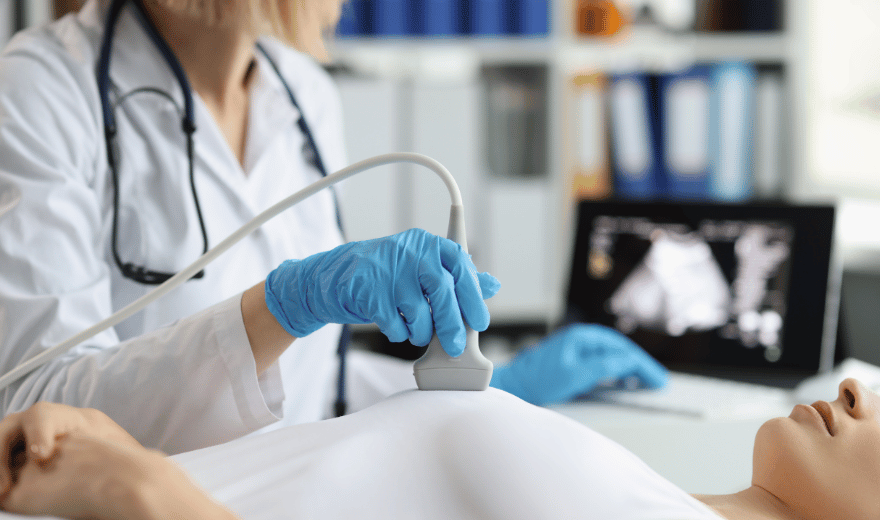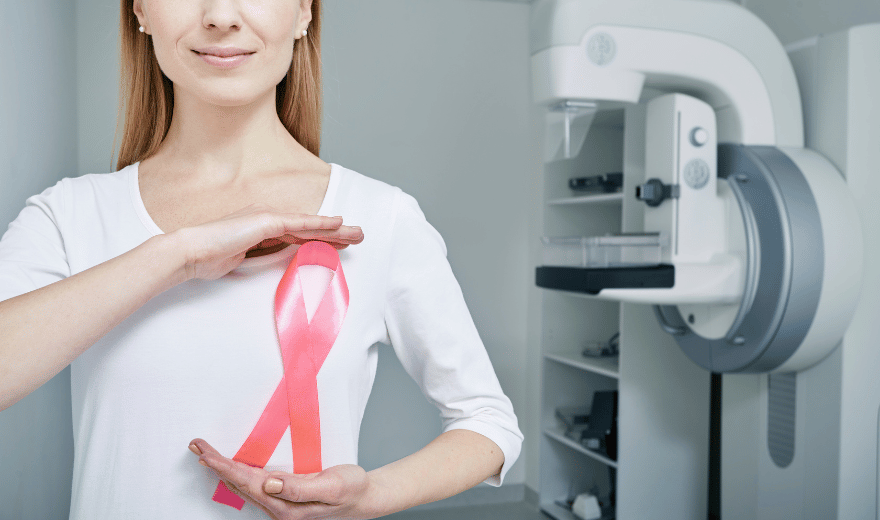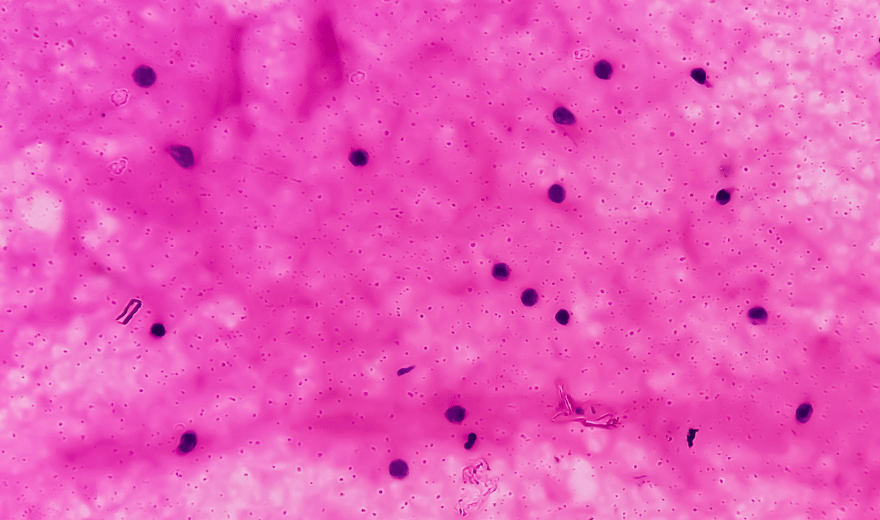
WHAT IS ULTRASOUND IMAGING OF THE BREAST?
Ultrasound imaging, also called ultrasound scanning or sonography, involves exposing part of the body to high-frequency sound waves to produce pictures of the inside of the body. Breast Ultrasound and Preparation examinations do not use ionizing radiation (as used in x-rays). Ultrasound imaging of the breast produces a picture of the internal structures of the breast.
WHAT ARE SOME COMMON USES OF THE PROCEDURE?
- Determining the Nature of a Breast Abnormality
The primary use of breast ultrasound today is to help diagnose breast abnormalities detected by a physician during a physical exam (such as a lump or bloody or spontaneous clear nipple discharge) and to characterize potential abnormalities seen on mammography or breast magnetic resonance imaging (MRI).
Ultrasound imaging can help to determine if an abnormality is solid (which may be a non-cancerous lump of tissue or a cancerous tumor) or fluid-filled (such as a benign cyst) or both cystic and solid. Ultrasound can also help show additional features of the abnormal area.
Doppler ultrasound is used to assess blood supply in breast lesions. - Supplemental Breast Cancer Screening
Mammography is the only screening tool for breast cancer that is known to reduce deaths due to breast cancer through early detection. Even so, mammograms do not detect all breast cancers. Some breast lesions and abnormalities are not visible or are difficult to interpret on mammograms. In breasts that are dense, meaning there is a lot of ducts, glands, fibrous tissue and less fat, many cancers can be hard to see on mammography.
Many studies have shown that ultrasound and magnetic resonance imaging (MRI) can help supplement mammography by detecting small breast cancers that may not be visible with mammography. MRI is more sensitive than ultrasound in depicting breast cancer, but MRI may not be available to all women. If screening MRI is performed, then screening ultrasound is not needed, though ultrasound may be used to characterize and biopsy abnormalities seen on MRI. When ultrasound is used for screening, many more abnormalities that may require biopsy are seen than are seen with mammography or MRI. These abnormalities usually are not cancer (false positives), and this limits its usefulness.
HOW SHOULD I PREPARE?
You will be asked to undress from the waist up and to wear a gown during the procedure. It is important to inform the radiologist and sonography of palpable abnormalities (either by your referring physician and/or yourself) and focal pain/tenderness, and their locations. Family history of breast cancer and previous breast surgery or procedures is also important. Comparison with prior breast mammograms and breast ultrasounds can be helpful. Please bring a copy of the report and/or prior studies with you to your ultrasound appointment.
HOW DOES THE PROCEDURE WORK?
Ultrasound imaging is based on the same principles involved in the sonar used by bats, ships, fishermen and the weather service. When a sound wave strikes an object, it bounces back, or echoes. By measuring these echo waves, it is possible to determine how far away the object is and its size, shape and consistency (whether the object is solid, filled with fluid, or both).
In medicine, ultrasound is used to detect changes in appearance of organs, tissues, and vessels or detect abnormal masses, such as tumors.
In an ultrasound examination, a transducer both sends the sound waves and receives/records the echoing waves. When the transducer is pressed against the skin, it directs small pulses of inaudible, high-frequency sound waves into the body. As the sound waves bounce off of internal organs, fluids and tissues, the sensitive microphone in the transducer records tiny changes in the sound’s pitch and direction. These signature waves are instantly measured and displayed by a computer, which in turn creates a real-time picture on the monitor. One or more frames of the moving pictures are typically captured as still images.
WHAT WILL I EXPERIENCE DURING AND AFTER THE PROCEDURE?
Most ultrasound examinations are painless, fast and easy.
After you are positioned on the examination table, the radiologist or sonographer will apply some warm water-based gel on your skin and then place the transducer firmly against your body, moving it back and forth over the area of interest until the desired images are captured. There is usually no discomfort from pressure as the transducer is pressed against the area being examined.
If scanning is performed over an area of tenderness, you may feel pressure or minor pain from the transducer.
You may be asked to change positions during the exam.
Once the imaging is complete, the gel will be wiped off your skin.
After an ultrasound examination, you should be able to resume your normal activities immediately. Who interprets the results and how do I get them?
A radiologist (a physician specifically trained to supervise and interpret radiology examinations) will analyze the images and send a signed report to your primary care physician or the physician who referred you for the exam, who will share the results with you.
Follow-up examinations are often necessary, and your doctor will explain the exact reason why another exam is requested. Sometimes a follow-up exam is done because a suspicious or questionable finding needs clarification with additional views or a special imaging technique. A follow-up examination may be necessary so that any change in a known abnormality can be detected over time. Follow-up examinations are sometimes the best way to see if treatment is working or if an abnormality is stable over time.
WHAT ARE THE LIMITATIONS OF ULTRASOUND IMAGING OF THE BREAST?
- Ultrasound is one of the tools used in breast imaging, but it does not replace routine screening mammography and careful clinical breast examination.
- Many cancers are not visible on ultrasound.
- Biopsy may be recommended to determine if a suspicious abnormality is cancer or not.
- Most suspicious findings on ultrasound that require biopsy are not cancers.
- Many calcifications seen on mammography cannot be seen on ultrasound. Some early breast cancers only show up as calcifications on mammography.
WHAT DOES THE EQUIPMENT LOOK LIKE?
Ultrasound scanners consist of a console containing a computer and electronics, a video display screen and a transducer that is used to do the scanning. The transducer is a small hand-held device that resembles a microphone, attached to the scanner by a cord. The transducer sends out inaudible high frequency sound waves into the body and then listens for the returning echoes from the tissues in the body. The principles are similar to sonar used by boats and submarines.
The ultrasound image is immediately visible on a video display screen that looks like a computer or television monitor. The image is created based on the amplitude (strength), frequency and time it takes for the sound signal to return from the area of the patient being examined to the transducer and the type of body structure the sound travels through.
HOW IS THE PROCEDURE PERFORMED?
You will lie on your back on the examining table and may be asked to raise your arm above your head.
A clear water-based gel is applied to the area of the body being studied to help the transducer make secure contact with the body and eliminate air pockets between the transducer and the skin that can block the sound waves from passing into your body. The sonographer (ultrasound technologist) or radiologist then presses the transducer firmly against the skin in various locations, sweeping over the area of interest or angling the sound beam from a farther location to better see an area of concern.
When the examination is complete, the patient may be asked to dress and wait while the ultrasound images are reviewed.
This ultrasound examination is usually completed within 30 minutes.
WHAT ARE THE BENEFITS VS. RISKS?
Benefits
- Most ultrasound scanning is noninvasive (no needles or injections) and is usually painless.
- Ultrasound is widely available, easy-to-use and less expensive than other imaging methods.
- Ultrasound imaging does not use any ionizing radiation.
- Ultrasound scanning gives a clear picture of soft tissues that do not show up well on x-ray images.
- Ultrasound imaging can help detect lesions in women with dense breasts.
- Ultrasound may help detect and classify a breast lesion that cannot be interpreted adequately through mammography alone.
- Using ultrasound, physicians are able to determine that many areas of clinical concern are due to normal tissue (such as fat lobules) or benign cysts. For most women 30 years of age and older, a mammogram will be used together with ultrasound. For women under age 30, ultrasound alone is often sufficient to determine whether an area of concern needs a biopsy or not.
Risks
- For standard diagnostic ultrasound there are no known harmful effects on humans.
- Interpretation of a breast ultrasound examination may lead to additional procedures such as follow-up ultrasound and/or aspiration or biopsy. Many of the areas thought to be of concern only on ultrasound turn out to be non-cancerous.
Preparation
BREAST ULTRASOUND
Ultrasound imaging, also called ultrasound scanning or sonography, involves exposing part of the body to high-frequency sound waves to produce pictures of the inside of the body. Ultrasound examinations do not use ionizing radiation (as used in x-rays). Ultrasound imaging of the breast produces a picture of the internal structures of the breast.
BREAST ULTRASOUND PREPARATION
These instructions are IMPORTANT. Please follow them.
- You will be asked to undress from the waist up and to wear a gown during the procedure.
- It is important to inform the radiologist and sonographer of palpable abnormalities (either by your referring physician and/or yourself) and focal pain/tenderness, and their locations. Family history of breast cancer and previous breast surgery or procedures is also important. Comparison with prior breast mammograms and breast ultrasounds can be helpful. Please bring a copy of the report and/or prior studies with you to your ultrasound appointment.
- Please let us know before your exam begins if you may be preg
continue reading
Related Posts
Cancer screening is testing done on people who may be at risk of getting cancer, but who have no symptoms and generally feel fine.
Ultrasound imaging of the scrotum is the primary imaging method used to evaluate disorders of the testicles and surrounding areas.
involves sending sound waves into the body. These sound waves reflect off the internal organs and are recorded by special instruments that create images of anatomic parts.



